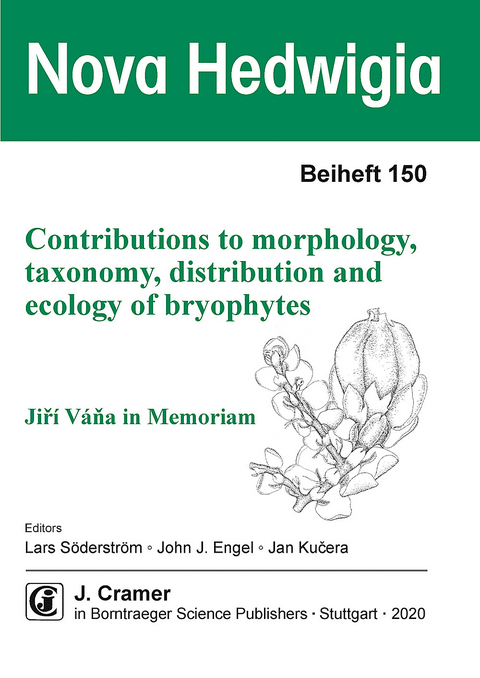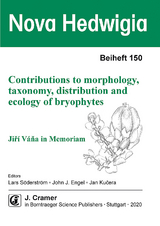Contributions to morphology, taxonomy, distribution and ecology of bryophytes
Jiří Váňa in memoriam
Seiten
The content of the contributions to this volume is diverse, and deals with morphology, taxonomy, distribution, and ecology of bryophytes. During the last 20 years much attention has been given to the morphology, development, and phylogeny of the liverwort Treubia, which occupies a pivotal position as one of the lineages in the first diverging clade in phylogenetic reconstructions of the Marchantiophyta. The important patterns of spore germination and sporeling development, while known for such genera as Haplomitrium, Fossombronia and Monoclea, had heretofore not been studied in Treubia. Crandall-Stotler & Bartholomew-Began (p. 57-66) found that, in fact, the early stages of sporeling ontogeny of Treubia resemble those of these three genera, but that there are considerable developmental differences among the taxa beyond the nine-celled stage of the sporelings. The early stages of germination and sporeling development, as well as apical cell formation, are nicely illustrated with line drawings and scanning electron micrographs. Molecular data helped to uncover or elucidate several unattended problems in various taxonomic groups and ranks. In one of them (Larraín et al.,p. 97-108), they were necessary even to suggest correctly the familial placement of a moss newly discovered in the Andes Mountains of central Chile and in the Falkland Islands. The extremely reduced morphology in both sporophytic and gametophytic traits could perhaps only unequivocally assign the species to the subclass Dicranidae, but molecular data convincingly pointed towards the poorly understood family Rhabdoweisiaceae. The authors provide a very useful and detailed analysis of the genera currently assigned to the family, and established a new genus, Notocynodontium, for their new peculiar moss. Two of the papers touched on generic delimitations: Kucera & Hedenäs (p. 165-178) revisited the genus Campyliadelphus and found that while the type species, C. chrysophyllus, should be merged with the genus Campylium, another currently accepted species, C. elodes has stronger affinities with Cratoneuron and Palustriella, necessitating the erection of a new genus, Kandaea, for C. elodes, and honouring thus the author, Hiroshi Kanda, who contributed significantly to the knowledge of Campylium-like species in the 1970s. Kucera et al. (p. 273-292) investigated the molecular affinities of two pottiaceous species recently recorded in Asian Russia, Bryoerythrophyllum sollmanianum and Tortula yuennanensis, and found again, how deceiving the superficial morphological similarities can be: While the latter species was found deeply nested in Bryoerythrophyllum and had to be combined into that genus (albeit with a new name, B. chenii), B. sollmanianum was found completely unrelated to the rest of Bryoerythrophyllum taxa, and a new genus, Pararhexophyllum, had to be described for it, acknowledging the molecular-phylogenetic affinities to the Central- and South American monospecific genus, Rhexophyllum. Ignatov et al. (p. 243-264), revisited a well-known genus, Fontinalis, which, however, harbours a suite of taxa difficult to delimit in both morphological and molecular way. Plants earlier referable to F. antipyretica var. gracilis were found to occur in two lineages; Asian specimens are referred to a resurrected species, F. perfida, while the European and West-Asian plants are retained a varietal rank within F. antipyretica, albeit with an older name, F. antipyretica var. minor. The unresolved relationships of some "small" taxa recognised by some authors and the nested position of F. squamosa within F. antipyretica s.str. awaits further taxonomic novelties in this group in the near future. Molecular data are also used to gain new insights into taxonomy and systematics of liverworts. Gradstein (p. 81-96) used both new molecular and morphological results in his review of the changes of classification of Lejeuneaceae genera in Tropical America since 2001. A major new classifica
| Erscheinungsdatum | 06.08.2020 |
|---|---|
| Reihe/Serie | Nova Hedwigia ; 150 |
| Sprache | englisch |
| Maße | 170 x 240 mm |
| Gewicht | 710 g |
| Themenwelt | Naturwissenschaften ► Biologie ► Botanik |
| Schlagworte | Biography • bryophyte flora • Vegetation |
| ISBN-10 | 3-443-51072-8 / 3443510728 |
| ISBN-13 | 978-3-443-51072-5 / 9783443510725 |
| Zustand | Neuware |
| Haben Sie eine Frage zum Produkt? |
Mehr entdecken
aus dem Bereich
aus dem Bereich
Gefäßpflanzen: Grundband
Buch | Hardcover (2021)
Springer Spektrum (Verlag)
CHF 62,95
Buch | Hardcover (2021)
Springer (Verlag)
CHF 125,95




